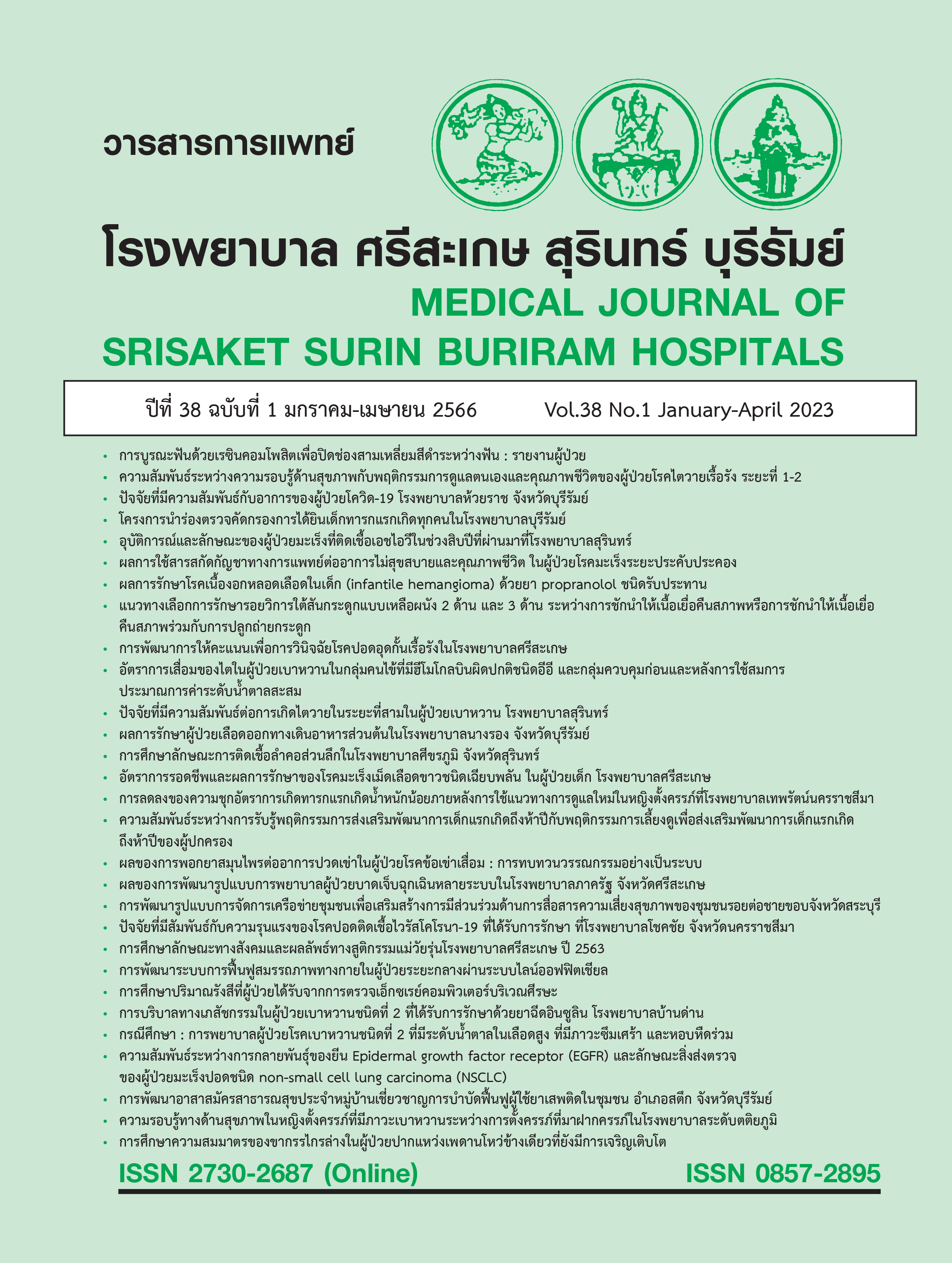โครงการนำร่องตรวจคัดกรองการได้ยินเด็กทารกแรกเกิดทุกคนในโรงพยาบาลบุรีรัมย์
Main Article Content
บทคัดย่อ
หลักการและเหตุผล: ความพิการจากการสูญเสียการได้ยินเป็นสาเหตุสำคัญอันดับต้นของความพิการในทารกแรกเกิดในประเทศกำลังพัฒนา ในปัจจุบันมีแนวทางการตรวจคัดกรองการได้ยินในทารกแรกเกิดทุกคนเพื่อให้สามารถวินิจฉัยตั้งแต่ระยะแรก คือ ก่อนอายุ 3 เดือน และเข้ารับการใส่เครื่องช่วยฟัง กระตุ้นพัฒนาการก่อนอายุ 6 เดือน จุดประสงค์ของการศึกษานี้คือ ประเมินอุบัติการณ์ของการสูญเสียการได้ยินของทารกในโรงพยาบาลบุรีรัมย์
วิธีการศึกษา: การศึกษาเชิงวิเคราะห์โดยเก็บข้อมูลแบบไปข้างหน้าคือ ทารกแรกเกิดทุกคนที่เกิดในโรงพยาบาลบุรีรัมย์ตั้งแต่เดือนกรกฎาคม พ.ศ. 2563 – มิถุนายน พ.ศ.2564 จะได้รับการตรวจคัดกรองการได้ยินด้วยเครื่อง Otoacoustic emissions (OAEs) ก่อนกลับบ้าน โดยทีมพยาบาลที่ได้รับการอบรมการตรวจคัดกรองการได้ยิน ในกรณีที่ทารกไม่ได้กลับบ้านพร้อมมารดา หลังกลับบ้านจะมีนัดตรวจการได้ยินอีก 1 สัปดาห์ ถ้าผลไม่ผ่านในครั้งแรกจะนัดมาตรวจซ้ำอีก 1 เดือน ถ้าไม่ผ่านในครั้งที่ 2 จะทำการตรวจการได้ยินด้วยเครื่อง automated auditory brain stem response (AABR)
ผลการศึกษา: จำนวนทารกทั้งหมด 4,896 คน ตรวจคัดกรองการได้ยิน (OAEs) 4,751 คน ไม่ได้รับการตรวจ 145 คน (ร้อยละ 2.9) ผลการตรวจผ่านในครั้งที่ 1 เป็นจำนวน 4,314 คน (ร้อยละ 90.8) ทารกที่ผลตรวจไม่ผ่านได้รับการตรวจ OAEs ครั้งที่ 2 พบว่า ทารกจำนวน 432 คน (ร้อยละ 98.9) ตรวจผ่านในครั้งที่ 2 และ ทารกจำนวน 5 คน (ร้อยละ 1.1) ตรวจไม่ผ่านและได้รับการตรวจ AABR เพื่อยืนยันการวินิจฉัย พบว่าทารกทุกคนตรวจ AABR ผ่านทั้งหมด
สรุป: อุบัติการณ์การสูญเสียการได้ยินในทารกที่โรงพยาบาลบุรีรัมย์จากการศึกษานี้ คือ ไม่พบผู้ป่วยโรคสูญเสียการได้ยิน
Article Details

อนุญาตภายใต้เงื่อนไข Creative Commons Attribution-NonCommercial-NoDerivatives 4.0 International License.
เอกสารอ้างอิง
Thompson DC, McPhillips H, Davis RL, Lieu TL, Homer CJ, Helfand M. Universal newborn hearing screening: summary of evidence. JAMA 2001;286(16):2000-10. doi: 10.1001/jama.286.16.2000.
Erenberg A, Lemons J, Sia C, Trunkel D, Ziring P. Newborn and infant hearing loss: detection and intervention.American Academy of Pediatrics. Task Force on Newborn and Infant Hearing, 1998- 1999. Pediatrics 1999;103(2):527-30. doi: 10.1542/peds.103.2.527.
World Health Organization. Newborn and infant hearing screening : current issues and guiding principles for action. Geneva: World Health Organization; 2010.
Yoshinaga-Itano C, Sedey AL, Coulter DK, Mehl AL. Language of early- and later-identified children with hearing loss. Pediatrics 1998;102(5):1161-71. doi: 10.1542/peds.102.5.1161.
Nelson HD, Bougatsos C, Nygren P, 2001 US Preventive Services Task Force. Universal newborn hearing screening: systematic review to update the 2001 US Preventive Services Task Force Recommendation. Pediatrics 2008;122(1):e266-76. doi: 10.1542/peds.2007-1422.
Northern JL, Downs MP. Hearing screening in children. In Norther JL, Downs MP, edited. Hearing in children. 5th ed. Baltimore: Lippincott Williams & Wilkins; 2002: 259-300.
กรมส่งเสริมและพัฒนาคุณภาพชีวิตคนพิการ กระทรวงการพัฒนาสังคมและความมั่นคงของมนุษย์. ข้อมูลประมวลผลจากฐานข้อมูลทะเบียนคนพิการ (ข้อมูล ณ วันที่ 15 กันยายน 2560). [อินเตอร์เน็ท]. [สืบค้นเมื่อ 15 สิงหาคม 2565]. ค้นได้จาก:URL: ตรวจสอบข้อมูลคนพิการ | กรมส่งเสริมและพัฒนาคุณภาพชีวิตคนพิการ (dep.go.th)
Finitzo T, Crumley WG. The role of the pediatrician in hearing loss. From detection to connection. Pediatr Clin North Am 1999;46(1):15-34, ix-x. doi: 10.1016/s0031-3955(05)70078-x.
American Academy of Pediatrics, Joint Committee on Infant Hearing. Year 2007 position statement: Principles and guidelines for early hearing detection and intervention programs.
Pediatrics 2007;120(4):898-921. doi: 10.1542/peds.2007-2333.
Robinette MS, Glattke TJ, editors. Otoacoustic Emission-Clinical Applications. 3rd. ed. New York: Thieme medical Publishers; 2007.
Stach B. Comprehensive dictionary of audiology illustrated 2nd. ed. New York: Thomson Delmar Learning; 2003.
Jariengprasert C, Sriwanyong S, Kasemsuwan L, Supapannachart S. Early identification of hearing loss in high risk newborns and young children by using otoacoustic emissions (OAEs) : a comparison study with auditory brain stem response (ABR). Asia Pacific J SLH 2002;7(1):1-9.
Brass D, Kemp DT. Quantitative assessment of methods for the detection of otoacoustic emissions. Ear Hear 1994;15(5):378-89. doi: 10.1097/00003446-199410000-00005.
Vohr BR, White KR, Maxon AB, Johnson MJ. Factors affecting the interpretation of transient evoked otoacoustic emission result in neonatal hearing screening. Semin Hear 1993;14(1):57–72. DOI: 10.1055/s-0028-1085105
Jacobson JT, Jacobson CA, Spahr RC. Automated and conventional ABR screening techniques in high-risk infants. J Am Acad Audiol 1990;1(4):187-95. PMID: 2132603
Jariengprasert C, Lerdsukprasert K, Kasemsuwan L, Nannareumitra P. Univeral newborn hearing screening using transient otoacoustic emissions: 1 year prevalence in Ramathibodi hospital. Thai J Otolaryngol HNS 2003;4(1):27-41.
Poonual W, Navacharoen N, Kangsanarak J, Namwongprom S. Prevalence and risk factors of hearing impairment in newborns under universal hearing screening program in northern Thailand. Proceeding of RSU international research conference 2016, 29 April 2016. Pathum Thani: Research Institute of Rangsit University; 2016: 36-45.
Pitathawatchai P, Khaimook W, Kirtsreesakul V. Pilot implementation of newborn hearing screening programme at four hospitals in southern Thailand. Bull World Health Organ 2019;97(10):663-71. doi: 10.2471/BLT.18.220939.
Mehar V, Somani P, Singh K, Munjal VR. Targeted hearing screening in newborns. Int J Contemp Pediatr 2016;3(1):159-63.
อรรถสิทธิ์ ศรีสุบัติ, ธนะรัตน์ อิ่มสุวรรณศรี, ตุลกานต์ มักคุ้น, อรุณี ไทยะกุล, สุรีพร คนละเอียด, กรชนก ลิมปิชัยโสภณและคณะ. การพัฒนารูปแบบการให้บริการตรวจคัดกรองการได้ยินในทารกแรกเกิดทุกคนระดับจังหวัด: การวิจัยเชิงปฏิบัติการ. วารสารกรมการแพทย์ 2564;46(1):160-9.
American Academy of Pediatrics, Joint Committee on Infant Hearing. Year 2007 position statement: Principles and guidelines for early hearing detection and intervention programs. Pediatrics 2007;120(4):898-921 doi: 10.1542/peds.2007-2333.
Saeed H, Alirezea OM, Fatemeh R. The sensitivity and specificity of automated auditory brainstem response and otoacoustic emission in neonatal hearing screening: a systematic review. In: Sokolowski B, editor. Auditory and Vestibular Research Methods and Protocol. 2nd. ed. Switzerland: Springer Nature; 2015:141-51.


